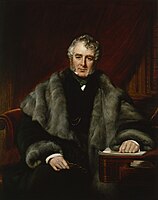Second Melbourne ministry
Second Melbourne ministry | |
|---|---|
| 1835–1841 | |
 | |
| Date formed | 8 April 1835 |
| Date dissolved | 30 August 1841 |
| People and organisations | |
| Monarch | William IV Victoria |
| Prime Minister | The Viscount Melbourne |
| History | |
| Election | 1835 general election |
| Outgoing election | 1841 general election |
| Predecessor | First Peel ministry |
| Successor | Second Peel ministry |
The second Lord Melbourne ministry was formed in the United Kingdom of Great Britain and Ireland by the Viscount Melbourne in 1835.
History
[edit]Lord Melbourne's second government came to power after Sir Robert Peel's minority government resigned in 1835. Lord Palmerston returned as Foreign Secretary while Lord John Russell held his first major office as Home Secretary.
In 1837 Queen Victoria succeeded to the throne, and as was usual for a queen regnant, the Royal Household was appointed by the Prime Minister. The young Queen was so attached to her Whig ladies of the bedchamber that after Melbourne's resignation in 1839, she refused to let Sir Robert Peel replace them with Conservative ladies. This was known as the Bedchamber Crisis, and led to Peel's refusal to form a government. Melbourne therefore resumed, and continued in office until the Conservatives finally won a House of Commons majority in the General Election of 1841. He was succeeded by Sir Robert Peel's second government.
1841 votes of no confidence
[edit]The 1841 votes of no confidence against the government of Viscount Melbourne were votes of no confidence in the government of William Lamb, 2nd Viscount Melbourne which occurred on 7 June 1841.[1] Melbourne lost the vote by only one vote and dissolved Parliament leading to an election in July 1841. Melbourne lost a second vote of confidence shortly after the election in August, leading to his resignation.
Cabinets
[edit]April 1835 – August 1839
[edit]Notes
[edit]- Viscount Duncannon served concurrently as Lord Privy Seal and First Commissioner of Woods and Forests.
August 1839 – September 1841
[edit]Notes
[edit]- Viscount Duncannon served concurrently as Lord Privy Seal and First Commissioner of Woods and Forests between August 1839 and January 1840.
- Lord Clarendon served concurrently as Lord Privy Seal and Chancellor of the Duchy of Lancaster between October 1840 and June 1841.
List of ministers
[edit]Members of the Cabinet are indicated by bold face.
- Notes
- ^ The Government resigned on 7 May 1839 following a defeat in Parliament. Queen Victoria invited Sir Robert Peel to form a government, who declined. Melbourne resumed in office from 10 May 1839.[2]
- ^ Also Leader of the House of Commons.
- ^ Created Baron Glenelg 8 May 1835.
- ^ Also Leader of the House of Commons.
- ^ Entered the Cabinet 20 February 1839.
- ^ a b c Office merged to become Paymaster-General 1 December 1836.
- ^ Created Baron Vivian 19 August 1841.
- ^ Permanent.
References
[edit]- ^ "British parliamentary timeline 1828 – 1900". Archived from the original on 31 March 2009. Retrieved 1 June 2009.
- ^ "Lord Melbourne (1779 – 1848)". BBC – History. Retrieved 3 June 2018.
- C. Cook and B. Keith, British Historical Facts 1830–1900
- British ministries
- Whigs (British political party)
- 1835 establishments in the United Kingdom
- 1841 disestablishments in the United Kingdom
- 1830s in the United Kingdom
- 1840s in the United Kingdom
- Ministries of William IV
- Ministries of Queen Victoria
- Cabinets established in 1835
- Cabinets disestablished in 1841
- William Lamb, 2nd Viscount Melbourne

